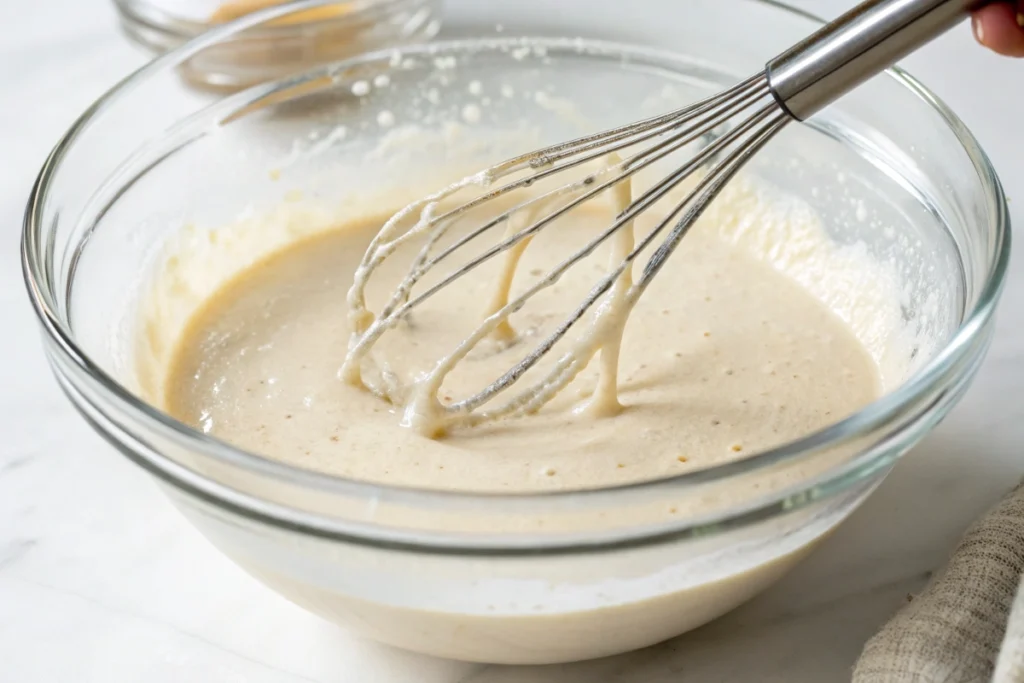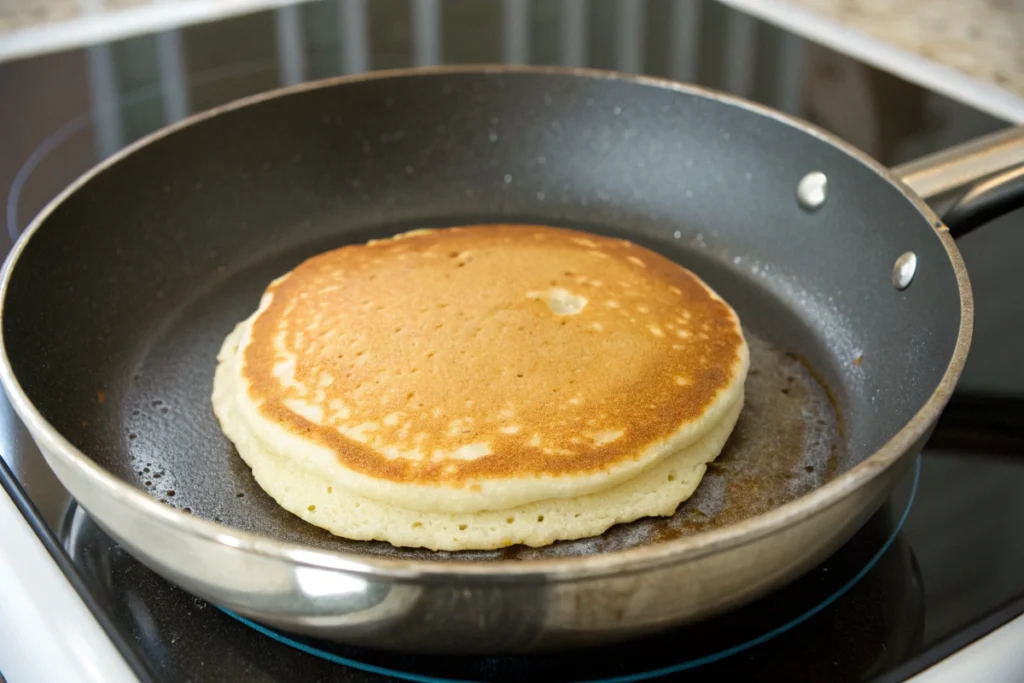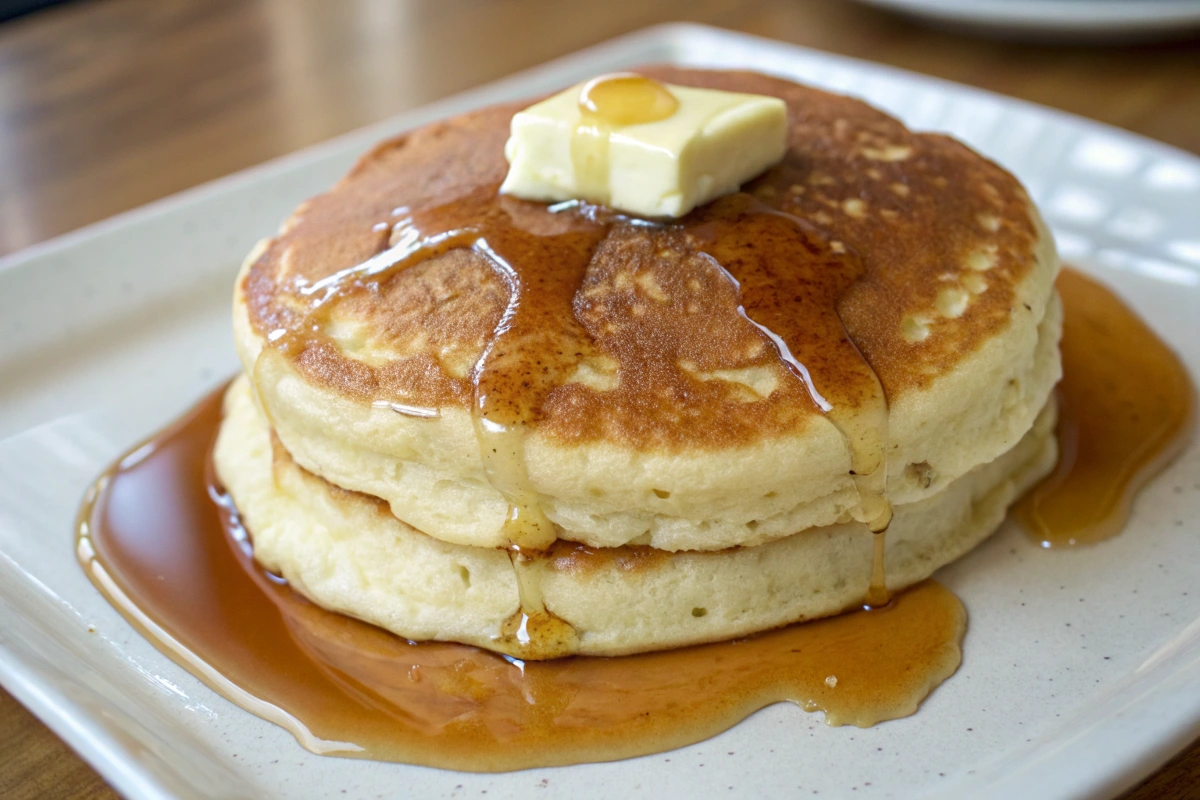Nothing beats waking up to a warm stack of soft, golden, and fluffy pancakes! Whether you’re preparing a special weekend breakfast or just craving something comforting, a well-made pancake can make all the difference. But what separates ordinary pancakes from truly fluffy, melt-in-your-mouth perfection?
In this guide, we’ll uncover the secrets behind the best fluffy pancake recipe and provide step-by-step instructions to help you master this breakfast classic. You’ll learn about the science of fluffiness, the best ingredients to use, and expert cooking techniques to ensure your pancakes turn out light, airy, and irresistibly delicious every time.
Introduction
The Secret to Soft and Airy Pancakes
Ever wondered why some pancakes are thick and fluffy while others turn out flat and dense? The secret lies in the balance of ingredients and mixing techniques. The right combination of flour, leavening agents, and liquid creates air pockets that expand while cooking, resulting in that pillowy-soft texture we all love.
Why Homemade Pancakes Beat Store-Bought Mixes
Sure, store-bought pancake mixes are convenient, but they often contain preservatives and artificial ingredients that compromise flavor and texture. When you make pancakes from scratch, you control every ingredient, ensuring a fresher, more natural taste. Plus, the ability to adjust sweetness, thickness, and flavor to your liking makes homemade pancakes far superior.
What This Guide Covers
This guide will take you through:
- The science behind achieving fluffines
- The best ingredients and substitutes for different diets
- A step-by-step foolproof recipe
- Common pancake mistakes and how to avoid them
- Delicious toppings and serving ideas
Now that you know what to expect, let’s dive into the science behind fluffy pancakes!
The Science Behind Fluffy Pancakes
The Role of Leavening Agents (Baking Powder & Baking Soda)
Leavening agents are the key to fluffiness in pancakes. But what’s the difference between baking powder and baking soda?
- Baking powder contains both an acid and a base, meaning it creates bubbles as soon as it gets wet and again when heated. This double reaction helps pancakes rise.
- Baking soda, on the other hand, needs an acidic ingredient (like buttermilk or lemon juice) to activate and create carbon dioxide bubbles. Without an acid, it won’t work properly.
A combination of both baking powder and baking soda gives pancakes the perfect lift!
Why the Right Flour Matters
Not all flours are created equal! Using the wrong type can affect the texture of your pancakes.
- All-purpose flour is the best choice for a balanced, fluffy texture.
- Cake flour results in a softer pancake, but it may lack structure.
- Whole wheat flour makes pancakes denser, but mixing it with all-purpose flour can add fiber while maintaining fluffiness.
The Importance of Resting Your Batter
A crucial but often overlooked step is letting your batter rest before cooking. This allows the flour to absorb the liquid, resulting in a smoother, more consistent texture. Plus, resting time allows the leavening agents to start working, ensuring your pancakes puff up beautifully.
Pro Tip: Let your batter rest for 5–10 minutes before cooking for the fluffiest results!
Now that we’ve covered the science behind fluffy pancakes, it’s time to gather the right ingredients and learn how to mix them properly.
Ingredients for the Best Fluffy Pancakes
Must-Have Ingredients for Extra Fluffiness
To achieve that perfect soft and airy texture, you’ll need the right combination of ingredients. Here’s what makes a difference:
- All-Purpose Flour – The ideal base for light and fluffy pancakes. Avoid using too much flour, or the pancakes may become dense.
- Baking Powder & Baking Soda – These leavening agents create air bubbles, making the pancakes rise beautifully. Using both ensures maximum fluffiness.
- Sugar – A touch of sugar enhances the flavor and helps create a slightly crisp, golden-brown surface.
- Eggs – Eggs add structure and moisture, keeping pancakes tender yet fluffy. Be sure to whisk them well!
- Milk or Buttermilk – Buttermilk adds tangy flavor and reacts with baking soda for extra fluff. If you don’t have buttermilk, mix 1 cup of milk with 1 tablespoon of vinegar as a substitute.
- Melted Butter or Oil – Butter adds richness, while oil helps maintain moisture. A mix of both gives the best results.
- Vanilla Extract & Salt – Vanilla enhances sweetness, while salt balances flavors and brings out the best taste in pancakes.
Secret Ingredients to Enhance Flavor
Want to take your pancakes to the next level? Try these secret additions:
- Greek Yogurt or Sour Cream – A spoonful adds extra moisture and richness.
- Sparkling Water or Club Soda – The bubbles introduce more air, making pancakes extra fluffy.
- Cinnamon or Nutmeg – A pinch of warm spices adds a subtle, cozy flavor.
Alternative Ingredient Options for Dietary Preferences
Everyone should be able to enjoy the best fluffy pancake recipe, even with dietary restrictions! Here are some easy swaps:
- Dairy-Free? Use almond milk, oat milk, or coconut milk instead of regular milk.
- Gluten-Free? Swap all-purpose flour for a gluten-free blend. Look for one with xanthan gum to maintain texture.
- Egg-Free? Use a flax egg (1 tablespoon flaxseed meal + 3 tablespoons water) as a substitute.
- Sugar-Free? Swap refined sugar with honey, maple syrup, or a sugar-free alternative.
Now that you have the perfect ingredients, let’s move on to the most important part—cooking your pancakes to perfection!
Step-by-Step Instructions for Perfect Pancakes
Prepping the Batter Without Overmixing

The way you mix your pancake batter can make or break the texture. Here’s the right way to do it:
- Combine the Dry Ingredients – In a large bowl, whisk together flour, baking powder, baking soda, sugar, and salt.
- Mix the Wet Ingredients Separately – In another bowl, whisk eggs, milk (or buttermilk), vanilla extract, and melted butter.
- Gently Combine – Pour the wet mixture into the dry ingredients and stir gently with a spatula.
- Avoid overmixing! A few lumps are okay—overmixing creates dense pancakes.
- Let the Batter Rest – Allow the batter to sit for 5–10 minutes so the leavening agents can start working.
Pro Tip: If the batter is too thick, add a splash of milk. If it’s too runny, sprinkle in a bit of flour.
The Best Temperature for Cooking Pancakes
Cooking pancakes at the right temperature is key to getting that golden-brown exterior with a fluffy inside.
- Use a non-stick pan or griddle and heat it over medium-low heat.
- Lightly grease the pan with butter or oil—too much can make pancakes greasy.
- Test the heat by sprinkling a few drops of water on the surface. If they sizzle and evaporate, it’s ready!

Pro Tip: Too much heat will burn the pancakes outside while leaving the inside raw. Stick to medium-low heat for even cooking!
Flipping Techniques for Even Cooking
Timing is everything when flipping pancakes! Follow these steps for a perfect flip:
- Pour the Batter – Use a ladle or measuring cup to pour even-sized pancakes onto the pan.
- Wait for Bubbles – When you see bubbles forming on the surface and the edges start to look dry (about 2 minutes), it’s time to flip
- Flip Gently – Use a thin spatula to slide under the pancake and flip it with a quick, confident motion.
- Cook the Other Side – Let the pancake cook for another 1–2 minutes until golden brown.
Pro Tip: Pressing down on pancakes after flipping deflates them—so resist the urge!
With these step-by-step techniques, you’re now equipped to make the best fluffy pancake recipe with ease.
Common Pancake Mistakes and How to Fix Them
Even if you follow the best recipe, pancakes can sometimes turn out flat, dense, or unevenly cooked. Here’s how to avoid the most common mistakes!
Why Your Pancakes Aren’t Fluffy
If your pancakes are coming out flat and lifeless, one of these could be the culprit:
- Expired Baking Powder or Baking Soda – Old leavening agents won’t create bubbles. Always use fresh baking powder and baking soda!
- Overmixing the Batter – Stirring too much develops gluten, making pancakes tough instead of light and airy.
- Skipping the Resting Time – Give your batter at least 5 minutes to allow the ingredients to work their magic.
Fix It: Use fresh leavening agents and mix the batter gently with a spatula, leaving a few lumps.
How to Avoid Dense and Rubbery Pancakes
If your pancakes feel heavy or chewy, here’s what may be going wrong:
- Too Much Flour – Adding extra flour makes the batter too thick, leading to dense pancakes.
- Not Enough Liquid – A dry batter won’t spread properly, causing thick, heavy pancakes.
- Overcooking on Low Heat – Cooking too slowly can dry out pancakes before they fully rise.
Fix It: Follow the recipe measurements precisely and cook pancakes at a steady medium-low heat.
Troubleshooting Uneven Cooking
Sometimes, pancakes cook unevenly, leaving you with burnt edges or raw centers. Here’s why:
- Pan is Too Hot – High heat burns the outside while the inside stays raw.
- Uneven Batter Spreading – If the batter isn’t spread evenly, pancakes cook inconsistently.
- Flipping Too Soon – Flipping too early stops the pancake from cooking evenly.
Fix It: Keep the heat medium-low, spread the batter evenly, and wait for bubbles before flipping.
With these troubleshooting tips, you’ll never have to deal with flat, dense, or uneven pancakes again! Now that you’ve mastered the best fluffy pancake recipe, let’s talk about toppings and serving ideas in the next part.
At this point, you’ve learned how to make the perfect pancake batter, mastered the best cooking techniques, and fixed common pancake mistakes. Now, let’s take your pancakes to the next level with delicious toppings and creative serving ideas! Now, we’ll also answer some frequently asked questions about the best fluffy pancake recipe, so you can enjoy the perfect stack every time.
Best Toppings and Serving Suggestions
Classic Toppings That Enhance the Taste
Some toppings never go out of style! These classics pair perfectly with fluffy pancakes:
- Maple Syrup & Butter – A golden stack of pancakes isn’t complete without warm maple syrup and a pat of butter melting on top.
- Fresh Berries & Whipped Cream – Blueberries, strawberries, and raspberries add a refreshing burst of flavor, while whipped cream brings a creamy touch.
- Nutella & Bananas – A rich and chocolaty twist, perfect for those who love a hint of indulgence.
- Peanut Butter & Honey – This protein-packed combo adds sweetness and a nutty richness.
- Powdered Sugar & Lemon Juice – A simple yet bright and tangy topping that enhances the natural flavors of pancakes.
Creative and Unique Pancake Combinations
Looking for something new? Try these fun and unexpected pancake toppings:
- Cinnamon Apples & Caramel Drizzle – Warm, spiced apples with a gooey caramel sauce make pancakes extra special.
- Greek Yogurt & Granola – A crunchy, protein-rich topping that adds texture and creaminess.
- Bacon & Maple Syrup – The perfect balance of sweet and savory—crispy bacon takes pancakes to another level.
- Chocolate Chips & Coconut Flakes – A tropical, chocolaty twist that adds extra sweetness and crunch.
- Savory Pancakes with Cheese & Herbs – Pancakes aren’t just for breakfast! Try topping them with cheddar, feta, or fresh herbs for a savory treat.
Pro Tip: Want even more variety? Create a pancake bar with different toppings and let everyone customize their own plate.
Pancake Mix Cookies Recipe – If you love pancakes, you might enjoy using pancake mix in a creative way to make delicious cookies.
How to Serve Pancakes Like a Pro
To make your pancakes look as good as they taste, follow these tips:
- Stack neatly – Place pancakes evenly on top of each other for that classic presentation.
- Drizzle sauces from the top – Whether it’s maple syrup, chocolate, or caramel, pour from the center of the stack for the perfect drip effect.
- Use colorful toppings – Fresh fruit, nuts, and whipped cream make pancakes visually appealing and more delicious.
- Serve warm – Nothing beats fresh, hot pancakes straight off the griddle. Keep them warm by placing them in a low-temperature oven (200°F) until ready to serve.
Now that you know how to serve up the best fluffy pancake recipe like a professional, let’s dive into some commonly asked questions to help you perfect your pancake game.
FAQs About Fluffy Pancake Recipe
What is the secret of fluffy pancakes?
The secret to fluffy pancakes lies in the right combination of ingredients and techniques. First, using baking powder and baking soda together helps create air bubbles, making the pancakes rise. Additionally, gently mixing the batter and letting it rest for a few minutes allows the ingredients to fully activate. Finally, cooking on medium-low heat ensures even rising, preventing pancakes from becoming dense or flat.
Why are IHOP pancakes so fluffy?
IHOP pancakes are so fluffy because they use buttermilk and fresh leavening agents, which create air pockets for a light texture. Additionally, they whip the batter gently to avoid overmixing, allowing it to stay airy. Moreover, letting the batter rest before cooking helps the ingredients activate, making the pancakes rise beautifully. Finally, they cook pancakes on a perfectly heated griddle, ensuring even cooking and a soft, fluffy interior.
Is baking soda or powder better for fluffy pancakes?
Both baking soda and baking powder play important roles in making pancakes fluffy, but they work differently. Baking powder is best for pancakes because it contains both an acid and a base, allowing it to create bubbles and rise without additional ingredients. However, baking soda works well when combined with an acidic ingredient like buttermilk or lemon juice, helping pancakes become even lighter. For the fluffiest texture, many recipes use a combination of both, ensuring maximum lift and softness.
Why are restaurant pancakes so fluffy?
Restaurant pancakes are so fluffy because they use fresh baking powder and baking soda, which create air bubbles for a light texture. Additionally, many restaurants use buttermilk, which reacts with leavening agents to enhance fluffiness. They also let the batter rest before cooking, allowing the ingredients to fully activate. Finally, pancakes are cooked on a perfectly heated griddle, ensuring even cooking and a soft, airy interior.
Conclusion
Mastering the best fluffy pancake recipe is easier than you might think, as long as you follow the right steps. From choosing the perfect ingredients to understanding the science behind fluffiness, every detail plays a role in creating light, airy, and delicious pancakes. By mixing the batter correctly, using the right cooking techniques, and avoiding common mistakes, you can ensure that each pancake turns out golden, soft, and perfectly cooked.
Once your pancakes are ready, the fun doesn’t stop there. With a variety of toppings—from classic maple syrup and butter to creative combinations like Nutella and bananas or peanut butter and honey—you can customize your stack to suit any taste. Whether you prefer something sweet, fruity, or even savory, there’s no shortage of ways to enjoy these irresistible breakfast favorites.
Now that you have all the tips, tricks, and step-by-step instructions, it’s time to put them into action. Grab your ingredients, heat up your pan, and start flipping! With this guide, you’ll never have to settle for flat, dense pancakes again. Instead, you’ll be able to create a tall, fluffy stack of perfection every time. Happy cooking!

